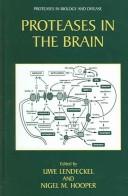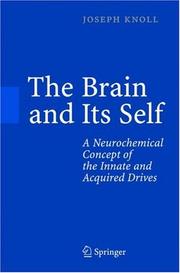| Listing 1 - 10 of 11 | << page >> |
Sort by
|
Book
ISBN: 1299402003 1907830731 9781907830730 9781905539734 1905539738 9781299402003 Year: 2013 Publisher: Keswick
Abstract | Keywords | Export | Availability | Bookmark
 Loading...
Loading...Choose an application
- Reference Manager
- EndNote
- RefWorks (Direct export to RefWorks)
This book was written after feedback suggested that stories and analogies were very helpful to students wanting to remember blood tests and their implications. For this reason each section, where appropriate, contains an analogy, in addition to an overview of the relevant anatomy, physiology and biochemistry. The book links tests and conditions, and gives strategies for clinical practice using simple language.It will be useful as a supplementary text for those studying nursing, healthcare and medicine. It will also provide a quick-reference handbook for working healthcare professionals. Finall
Blood --- Analysis of blood --- Blood chemistry --- Blood tests --- Clinical chemistry --- Analysis. --- Analysis and chemistry --- Chemistry
Book
ISBN: 190783088X 9781907830884 9781905539888 1905539886 1299737587 9781299737587 Year: 2013 Publisher: Keswick, Cumbria
Abstract | Keywords | Export | Availability | Bookmark
 Loading...
Loading...Choose an application
- Reference Manager
- EndNote
- RefWorks (Direct export to RefWorks)
Now in its third edition, this essential handbook for nurses and allied health professionals gives clear, simple explanations of blood results, focusing on routinely requested investigations. There have been many changes since the second edition - from alterations in units (such as g/L for haemoglobin, rather than g/dL) to the merging of haematology with biochemistry, blood transfusion and immunology to form blood science. Accordingly, in this new edition there are more details of immunology, immunological diseases, and the blood tests involved.
Blood --- Analysis of blood --- Blood chemistry --- Blood tests --- Clinical chemistry --- Analysis. --- Analysis and chemistry --- Chemistry
Book
ISBN: 2742013245 9782742013241 9782742007356 Year: 2011 Publisher: Montrouge, France
Abstract | Keywords | Export | Availability | Bookmark
 Loading...
Loading...Choose an application
- Reference Manager
- EndNote
- RefWorks (Direct export to RefWorks)
Blood --- Diseases --- Immunological aspects. --- Analysis. --- Analysis of blood --- Blood chemistry --- Blood tests --- Analysis and chemistry --- Chemistry --- Clinical chemistry --- Body fluids --- Fear of blood
Book
ISBN: 1280569433 9786613599032 1617050156 9781617050152 9781933864754 1933864753 Year: 2012 Publisher: New York, NY : Demos Medical Pub.,
Abstract | Keywords | Export | Availability | Bookmark
 Loading...
Loading...Choose an application
- Reference Manager
- EndNote
- RefWorks (Direct export to RefWorks)
Multiple Myeloma and Related Serum Protein Disorders is a practical guide to the clinical use of serum and urine electrophoresis and also includes coverage of immunofixation electrophoresis. These techniques are essential in the accurate identification of monoclonal gammopathies and the diagnosis of multiple myeloma and related disorders. Interpretation is often challenging even for the experienced practitioner. Throughout the book the emphasis is on indications and practical aspects of interpreting test results. Particular attention is paid to differentiating false negative and false positive
Blood protein electrophoresis. --- Blood --- Analysis of blood --- Blood chemistry --- Blood tests --- Clinical chemistry --- Blood proteins --- Electrophoresis --- Analysis. --- Analysis and chemistry --- Chemistry --- Analysis --- Separation
Book
ISBN: 0199914028 9780199914029 1306197406 9781306197403 9780199914012 019991401X Year: 2014 Publisher: New York : Oxford, University Press,
Abstract | Keywords | Export | Availability | Bookmark
 Loading...
Loading...Choose an application
- Reference Manager
- EndNote
- RefWorks (Direct export to RefWorks)
We're all familiar with the idea that plant-derived chemicals can have an impact on the functioning of the human brain. Most of us reach for a cup of coffee or tea in the morning, many of us occasionally eat some chocolate, some smoke a cigarette or take an herbal supplement, and some people use illicit drugs. We know a great deal about the mechanisms by which the psychoactive components of these various products have their effects on human brain function, but the question of why they have these effects has been almost totally ignored. This book sets out to describe not only how, but more impo
Phytochemicals. --- Brain chemistry. --- Brain --- Neurochemistry --- Botanical chemicals --- Plant chemicals --- Chemicals --- Botanical chemistry --- Analysis and chemistry --- Biomolécules végétales. --- Cerveau --- Chimie. --- Biomolécules végétales.

ISBN: 1280618671 9786610618675 0387251510 0387251499 1441937757 Year: 2005 Volume: v. 4 Publisher: Dordrecht : Springer,
Abstract | Keywords | Export | Availability | Bookmark
 Loading...
Loading...Choose an application
- Reference Manager
- EndNote
- RefWorks (Direct export to RefWorks)
The ADAM Family of Proteases provides the first comprehensive review of the roles of ADAMs and the related ADAMTS proteases in biology and disease. Although a few members of the ADAM (a disintegrin and metalloprotease) family have been known for some time, it is only in recent years through advances in genome sequencing that the large size of this family of zinc metalloproteases has become apparent. These proteins have multiple domains including a protease domain and a disintegrin domain. A branch of the family, called ADAMTS, also have thrombospondin-like motifs. The role of ADAMs and ADAMTS members in a diversity of biological processes is gradually coming to light. For example, some ADAMs have critical roles in the ectodomain shedding of membrane proteins including tumour necrosis factor-a, the cell signalling molecule Notch and the Alzheimer’s amyloid precursor protein. Other ADAM and ADAMTS family members have key roles to play in sperm function and fertility, collagen processing, development, cardiac hypertrophy and arthritis.
Proteolytic enzymes. --- Proteinase. --- Brain --- Brain chemistry. --- Pathophysiology. --- Peptide hydrolases --- Proteases --- Hydrolases --- Cerebrum --- Mind --- Central nervous system --- Head --- Proteolytic enzymes --- Neurochemistry --- Analysis and chemistry --- Biochemistry. --- Biochemistry, general. --- Biological chemistry --- Chemical composition of organisms --- Organisms --- Physiological chemistry --- Biology --- Chemistry --- Medical sciences --- Composition

ISBN: 1280613386 9786610613380 0387231013 0387231005 1441935738 Year: 2005 Volume: v. 3 Publisher: New York : Springer,
Abstract | Keywords | Export | Availability | Bookmark
 Loading...
Loading...Choose an application
- Reference Manager
- EndNote
- RefWorks (Direct export to RefWorks)
In all organs of the body proteases have critical roles to play both in normal development and functioning and in disease states. The brain is no exception to this, with proteases having emerging roles in synaptic plasticity, memory, neurodegenerative disorders such as Alzheimer’s, Parkinson’s and prion diseases, ischemia and traumatic brain injury, inflammatory and infectious diseases, and tumour progression. Proteases in the Brain brings together a wide range of topics under this central theme and highlights the large number of proteases involved in these normal and disease processes. Proteases in the Brain reviews the role and regulation of proteases in Alzheimer’s disease brain ischemia and traumatic brain injury human glioma inflammatory and infectious diseases of the central nervous system metabolism of the prion protein modulating synaptic activity multiple sclerosis neuronal plasticity and memory consolidation Parkinson’s disease processing, conversion and inactivation of neuropeptides. Proteases in the Brain is a timely and useful source of information both for those well versed in the role of proteases in the brain and for those who are beginning to realize the important role of this family of enzymes in brain function and dysfunction.
Brain --- Proteinase. --- Brain chemistry. --- Pathophysiology. --- Neurochemistry --- Proteolytic enzymes --- Cerebrum --- Mind --- Central nervous system --- Head --- Analysis and chemistry --- Biochemistry. --- Neurosciences. --- Biochemistry, general. --- Neural sciences --- Neurological sciences --- Neuroscience --- Medical sciences --- Nervous system --- Biological chemistry --- Chemical composition of organisms --- Organisms --- Physiological chemistry --- Biology --- Chemistry --- Composition

ISBN: 1280234938 9786610234936 3540274340 3540239693 3642421423 Year: 2005 Publisher: Berlin ; New York : Springer,
Abstract | Keywords | Export | Availability | Bookmark
 Loading...
Loading...Choose an application
- Reference Manager
- EndNote
- RefWorks (Direct export to RefWorks)
The main message of this monograph is that the appearance of the mammalian brain with the ability to acquire drives ensured the development of social life, and eventually led to the evolution of the human society. This most sophisticated form of organized life on earth is still in the trial and error phase of its development. It seeks to outgrow the myth-directed era of its history and come to its final state, the ration-directed human society.
Neurochemistry. --- Brain chemistry. --- Brain --- Neurochemistry --- Biochemistry --- Neurosciences --- Analysis and chemistry --- Neurosciences. --- Animal behavior. --- Psychology, clinical. --- Psychopharmacology. --- Behavioral Sciences. --- Neuropsychology. --- Behavioral pharmacology --- Drugs --- Chemotherapy --- Pharmacology --- Psychotropic drugs --- Animals --- Animals, Habits and behavior of --- Behavior, Animal --- Ethology --- Animal psychology --- Zoology --- Ethologists --- Psychology, Comparative --- Neural sciences --- Neurological sciences --- Neuroscience --- Medical sciences --- Nervous system --- Psychotropic effects --- Behavior --- Behavioral sciences. --- Neurophysiology --- Psychophysiology
Book
ISBN: 1608051471 9781608051472 9781608055289 Year: 2012 Publisher: [Saif Zone, Sharjah, UAE] Bentham eBooks
Abstract | Keywords | Export | Availability | Bookmark
 Loading...
Loading...Choose an application
- Reference Manager
- EndNote
- RefWorks (Direct export to RefWorks)
On-chip pretreatment of whole blood is one of the hottest topics in lab-on-a-chip research since whole blood has been regarded as the most important clinical sample. This e-book is a valuable reference for readers interested in this specific clinical application of advanced MEMS technology.
Microelectromechanical systems. --- Microfluidic devices. --- Blood --- Analysis of blood --- Blood chemistry --- Blood tests --- Clinical chemistry --- Fluidic devices --- Microtechnology --- MEMS (Microelectromechanical systems) --- Micro-electro-mechanical systems --- Micro-machinery --- Microelectromechanical devices --- Micromachinery --- Micromachines --- Micromechanical devices --- Micromechanical systems --- Electromechanical devices --- Mechatronics --- Analysis. --- Analysis and chemistry --- Chemistry
Book
ISBN: 1848829221 1848003072 184882923X 1848003080 Year: 2009 Publisher: London : Springer,
Abstract | Keywords | Export | Availability | Bookmark
 Loading...
Loading...Choose an application
- Reference Manager
- EndNote
- RefWorks (Direct export to RefWorks)
Taking both a historical and philosophical stance, Brain Imaging: The Chemistry of Mental Activity provides a detailed account of molecular imaging at its finest. Written by Dr. Henry N. Wagner Jr, a highly acclaimed author and international authority in the field of nuclear medicine, the book brings to date all the exciting work present in brain imaging, showing the differences among the various imaging modalities, and reviewing the knowledge of chemical reactions in the brain. Suitable for both professionals and the public alike; this book spans basic principles through to historical and current uses of molecular imaging. The vast utility of imaging is highlighted by examining common themes and topics prominent in human life; love, aggression, altruism, violence, crime, and substance abuse to name a few. Dr. Henry N. Wagner Jr, a pioneer in nuclear medicine, has made groundbreaking contributions to advancing the fields of radiology and nuclear medicine, namely in the areas of brain physiology and pathophysiology, and addiction and drug design. He is a member of the Institute of Medicine of the US National Academy of Sciences, as well as several editorial boards and many other medical and radiological societies, and is an honorary member of the British Institute of Radiology (2000). During his time at the Johns Hopkins University he has trained more than 500 radiologists, internists, physicians, and scientists, eight of whom have held, as he has, the position of President of the Society of Nuclear Medicine. In 1985 he was awarded the Georg Von Hevesy Award and in 1993 Dr. Wagner was awarded the first Annual Society of Nuclear Medicine President’s Award for Outstanding Contributions to nuclear medicine.
Brain -- Imaging. --- Brain. --- Medicine. --- Brain --- Neurochemistry --- Magnetic Resonance Imaging --- Brain Diseases --- Diagnosis --- Diagnostic Techniques, Neurological --- Methods --- Investigative Techniques --- Analytical, Diagnostic and Therapeutic Techniques and Equipment --- Central Nervous System Diseases --- Diagnostic Imaging --- Diagnostic Techniques and Procedures --- Tomography --- Nervous System Diseases --- Diseases --- Radiology, MRI, Ultrasonography & Medical Physics --- Neurology --- Medicine --- Health & Biological Sciences --- Imaging --- Brain chemistry. --- Imaging. --- Analysis and chemistry --- Neurosciences. --- Radiology. --- Neuroradiology. --- Nuclear medicine. --- Medical biochemistry. --- Medicine & Public Health. --- Imaging / Radiology. --- Nuclear Medicine. --- History of Medicine. --- Medical Biochemistry. --- History. --- Radiology, Medical. --- Biochemistry. --- Clinical radiology --- Radiology, Medical --- Radiology (Medicine) --- Medical physics --- Biological chemistry --- Chemical composition of organisms --- Organisms --- Physiological chemistry --- Biology --- Chemistry --- Medical sciences --- Neural sciences --- Neurological sciences --- Neuroscience --- Nervous system --- Clinical sciences --- Medical profession --- Human biology --- Life sciences --- Pathology --- Physicians --- Atomic medicine --- Radioisotopes in medicine --- Medical radiology --- Radioactive tracers --- Radioactivity --- Composition --- Physiological effect --- Health Workforce --- Medicine—History. --- Medical biochemistry --- Pathobiochemistry --- Pathological biochemistry --- Biochemistry --- Neuroradiography --- Neuroradiology --- Radiological physics --- Physics --- Radiation
| Listing 1 - 10 of 11 | << page >> |
Sort by
|

 Search
Search Feedback
Feedback About UniCat
About UniCat  Help
Help News
News